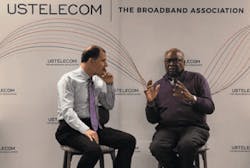Executive Insights: Jonathan Spalter, President and CEO, USTelecom – The Broadband Association
Read Jonathan’s thoughts about members’ network challenges during the COVID-19 pandemic, representing them in Washington, D.C., and USTelecom’s priorities for 2021.
ISE: Jonathan, give us some background about USTelecom – The Broadband Association.
Spalter: USTelecom – The Broadband Association is the place where all conversations — and effective advocacy — about the future of connectivity takes place. USTelecom’s members include broadband and technology innovators working together to connect our families, communities, and enterprises, to the future. Our diverse membership ranges from local Main Street companies and heartland cooperatives to large global technology leaders — all of whom have stepped-up and stood tall during this COVID-19 pandemic emergency to ensure continued access to communications services for all citizens regardless of where they live and work. By bringing together all of the diverse parts of our communications ecosystem, we deliver a singular and united voice to policymakers, and ensure that all our members can invest and innovate in the networks of the future — and all the opportunities that come with it.
Topic: Pain Points
ISE: What are your members’ biggest challenges right now? What is USTelecom doing to help them?
Spalter: As the world confronts this unprecedented global health and economic challenge, we know that broadband has never been more indispensable. Our economy and our neighbors have been hit hard, but you can only imagine the body blow to productivity and our shared sense of community if this hit in an era when we had no high-speed connectivity.
Biggest challenges:
First, ensure our critical broadband workers are safe and healthy and have access to essential personal protective equipment. Some functions can be handled only in person, so we worked with the federal government to designate broadband employees as essential critical workers, and we pushed leaders in Washington to make good on providing PPE.
Second, continue to drive progress so that nobody is left behind during this moment while accelerating our ongoing work to finish the job of connecting the entire country. We are investing $70-80 billion annually to connect new communities, upgrade infrastructure, and innovate our networks, but private investment alone can’t finish the connectivity job. My message to Washington: #InvestInBroadband, and pass smart bipartisan policies that cut through the red tape, eliminate bureaucratic roadblocks to deployment, and allow providers and their technology partners to compete, invest, innovate, and thrive, on a level playing field in our dynamic marketplace.
InvisiLight® Solution for Deploying Fiber
April 2, 2022Go to Market Faster. Speed up Network Deployment
April 2, 2022Episode 10: Fiber Optic Closure Specs Explained…
April 1, 2022Food for Thought from Our 2022 ICT Visionaries
April 1, 2022Topic: Fiber and 5G
ISE: Post COVID-19, the 5G infrastructure market is estimated to grow from $12.6 billion in 2020 and projected to reach $44.9 billion by 2025 — a CAGR of 28.97%. The projection for 2025 is estimated to be down by 22.79% compared to pre-COVID-19 estimation. (Source: https://www.businesswire.com/news/home/20200424005429/en/COVID-19s-Impact-5G-Infrastructure-Market-Communication-Infrastructure) While 5G is being slowed by COVID-19, what are your members doing to adopt innovative deployment approaches for FTTx and next-gen wireless networks?
Spalter: 5G is not being slowed by the COVID-19 pandemic. In reality, this next-generation technology has already arrived in numerous American cities, and will ramp up this year and beyond. What will carry 5G traffic? America’s wired communications networks. That’s what is so exciting. 5G will not only enable transformative new services — the Internet of Things, connected cars, telehealth, and precision agriculture — it will create economic productivity and jobs.
Here’s how I think about it. The future of wireless is inextricably linked to our ability to deploy fiber infrastructure across the country. 5G is only wireless for the Last Mile, and I tell policymakers all the time: if you want to bring the power of 5G to hard-to-reach communities — beyond just our big cities — help us extend wired networks deeper into areas where we need to scale our communications infrastructure and lay lots (and lots) of fiber.
"Our diverse membership ranges from local Main Street companies and heartland cooperatives to large global technology leaders — all of whom have stepped-up and stood tall during this COVID-19 pandemic emergency to ensure continued access to communications services for all citizens regardless of where they live and work."
Topic: Public and Private Investments
ISE: You recently said: "I encourage Congress to continue to look for ways to both ensure that customers can afford the broadband they need and keep providers on sound financial footing as they continue to do everything possible to keep our nation connected." Share 3 of the most viable solutions to make that happen.
Spalter: Our goal must be 100% connectivity for all Americans. Full stop. We’ve pursued this public policy goal for some time, but incremental approaches with limited budgets, combined with rapid redefinitions of how we use and integrate broadband into our lives, has left too many Americans still without the access they need. That’s unacceptable.
The economic, social, and human, challenges of this are well documented, and connecting the last 1% to 2% of Americans is going to be costly. Different entities and even Congress, have identified various funding targets for ubiquitous fiber broadband, some of which exceed $100 billion. This is a significant amount of money, but if that is what it takes to get the job done, I say then let’s get it done.
We can’t stop there.
I speak regularly to many members of Congress, and here’s my message: adopt a legislative framework that capitalizes on the work, preparation, and expertise, of the government agencies it has already charged with meeting our nation’s broadband needs. The best programs are the ones that were implemented deliberately, well thought-out with both government and industry input, and that can provide nearly immediate results. Congress should provide substantial additional funding to the FCC so that it can allocate to programs such as the Rural Digital Opportunity Fund (RDOF) as well as the Alternative Connect America Cost Model (ACAM) at levels that will achieve 100% fiber broadband connectivity nationwide.
Spalter with U.S. Senator Ed Markey (D) of Massachusetts.
Topic: Cost-Cutting
ISE: As more businesses enable remote work and consumers switch to unlimited plans, telcos have an opportunity: if they can support remote work while giving consumers a positive experience throughout the crisis, their brand perception will be improved. Still, telcos face financial uncertainty caused by the COVID-19 pandemic. So, they must plan accordingly. In the long term, challenges will include cost-cutting, as commodity services will likely become cheaper. What does this mean for your members’ teams?
Spalter: The value of broadband has never been clearer. As the global economy shut down, USTelecom members worked tirelessly, and often in harm’s way, to keep America’s Internet open and our communities connected. Our members not only joined the FCC’s Keep Americans Connected Pledge, but they consider their commitment to connectivity a core value and worked with customers facing economic uncertainty. But it’s not always easy, and it does come at a cost. Many of our members are local and regional Main Street enterprises and cooperatives, and feeling the financial strain, too.
We’re glad to be delivering more broadband to more families and enterprises than ever before.
Here’s why broadband will not be a commodity — there is more competition and innovation than ever before with providers constantly evolving and delivering a variety of new services and network technologies with new applications and new options. Innovative and dynamic businesses can’t be commodified.
Spalter with House Majority Whip James Clyburn (D) of South Carolina.
Topic: Supply Chain
ISE: What issues do your members face related to supply chain? Are there some suggestions you have for the vendor community to help remedy these challenges?
Spalter: Supply chain security, diversity, and availability, matters. A lot.
During the COVID-19 pandemic, we’ve seen the global supply chain come under stress, especially network components. Complex issues of international commerce, diplomacy, and national security, also impact our supply chain outlook. USTelecom has become an essential place where supply chain solutions can be forged. We chair the Communications Sector Coordinating Council at the Department of Homeland Security (DHS). And we co-chair the Information and Communications Technology (ICT) Supply Chain Risk Management Task Force at DHS, a first of its kind public-private partnership to identify and manage risk to the global ICT supply chain.
One of the things we’ve been advocating for is consistency across the government. It becomes a problem when Congress uses one definition of suspect equipment and the FCC uses another. USTelecom is creating a platform that encourages stability — and certainty — for future network investment so we need the federal government to be on the same page.
Topic: Cultural Transformation
ISE: Explain why cultural transformation is as important as technical transformation to ensure that Communications Service Providers thrive in the future.
Spalter: We are a community of innovators. That doesn’t just mean excellence in technology, but fundamentally it means our members are in the business of creating opportunity, connecting communities everywhere, and bringing humanity together. We have an obligation to work as an industry to build a more inclusive country, and to ensure that we have the best-trained and most inclusive workforce possible — including our own. This includes the frontline, in the executive suite, and in the boardroom. Our members understand this, and they are making commitments to championing new voices and new perspectives across all facets of their operations. The way we innovate in our workplace is key to how we innovate for our customers.
Spalter, USTelecom Board of Directors with U.S. Congressman Marc Veasey (D) of Texas.
Topic: Priorities
ISE: What are 2 of USTelecom’s top priorities for the next 18 months?
Spalter: There are 3 top priorities, and they are interrelated.
First, ensuring investment by working with government to extend broadband.
Second, boosting digital trust by fighting illegal robocalls, shoring-up the cooperation needed to keep our networks secure, maintaining our open Internet, and passing a strong national privacy framework that treats all parts of the digital ecosystem the same.
Finally, tearing down the barriers to deployment that we know exist. This means we have to continue the hard but necessary work of dragging many of the tired old analog and thumb-on-the-scales rules still on the books that hamper broadband access for consumers and weigh-down competition in our nation, along with the backwards-looking hyper-regulatory mindsets that champion them, fully and finally into our pro-consumer, fiber-broadband-fueled dynamic modern digital era — even if they are kicking and screaming.
This is not a partisan project. The ones and zeroes comprising our Internet and traversing our networks are neither red nor blue. If we are to fully put the Digital Divide in our rear-view mirror, Congress and the executive branch must examine some of the outdated and legacy regulations that don’t get headlines but play a major role in slowing broadband builds. The fact of the matter is slow government approvals and rights-of-way and permitting disputes hold back broadband construction and deployment.
I can’t tell you how many of our network innovators — and their customers — bump into red tape and rules that make these essential infrastructure projects slower, more expensive, or nearly impossible to get off the ground. If Washington wants to help consumers, especially those in corners of the country that need 21st Century connectivity, streamlining regulations and creating a level-playing field for all
competitors are great places to start.
Topic: Overlooked Issues
ISE: What should all of us in the Information and Communication Technology (ICT) industry be talking about that we are not? Or, what current topic is the most important that needs additional and different attention?
Spalter: A shared vision and common effort to advance the security, resiliency, and interdependence, of the technologies that comprise our networks that includes the good (IoT) to the bad (botnets), and everything in between. We need a conversation about how to work together if we ever have a very bad day in cyberspace. I am proud the Council to Secure the Digital Economy (CSDE) we founded, which includes several of the world’s largest and most innovative ICT enterprises, has become a central venue for this practical, solutions-driven collaboration. But this is not just an ICT project. Increasingly, ALL sectors understand their reliance on the underlying network technologies that impact their businesses. This includes transportation, finance, energy, healthcare, and beyond. They too must join us in this work and as our partners. And we welcome them.
"The future is increasingly driven by cloud, virtualization, open standards, and the promise that permissive innovation will always be a better formula — and we’re going to continue to make investments in the core infrastructure that will get us to 5G, 6G, and beyond."
Topic: The Future
ISE: What emerging or disruptive technology excites you the most for the ICT industry? Why?
Spalter: The short answer: who knows? Which is what makes this work so exciting. The future is increasingly driven by cloud, virtualization, open standards, and the promise that permissive innovation will always be a better formula — and we’re going to continue to make investments in the core infrastructure that will get us to 5G, 6G, and beyond.
Our networks are evolving to accommodate permissive innovation over government controls and mandates. We should not put our efforts into backing a single horse or turning our networks over to the government (a supremely bad idea). Rather, we should be supporting a diverse field of vendors to minimize economic and national security risks, and encourage next-generation technologies like Open RAN. Innovation is going to be key here. Moving to software-based and virtualized networks will help reduce dominance by one country or a single provider.
Topic: Risk
ISE: What’s the biggest professional risk you’ve taken?
Spalter: Does having a supporting actor role in a Hong Kong Kung Fu movie count?
Topic: Guidance
ISE: What professional and leadership guidance would you offer a younger Jonathan Spalter as he was forging his career path?
Spalter: I think the business leader and Chief Diversity Officer Maria Castañón Moats said it best: Cultivate a network of trusted mentors and colleagues. Other people can give us the best insight into ourselves — and
our own limitations. We must have the courage to ask for help and to request
feedback to expand our vision of what’s possible.
Topic: Your Role
ISE: What would you recommend to someone who wants to achieve a high-level position in his/her career?
Spalter: Strive constantly to make new mistakes.
Remember the old axiom: It is amazing what you can accomplish if you do not care who gets the credit.
And always recognize that every team member, no matter their role or station in your organization, matters.
Like this Article?
Subscribe to ISE magazine and start receiving your FREE monthly copy today!
Jonathan Spalter is President and CEO of USTelecom – The Broadband Association. USTelecom is the national trade association representing technology providers, innovators, suppliers, and manufacturers, committed to connecting the world through the power of broadband. Visit USTelecom at https://www.ustelecom.org/.
Twitter: @Jspalter
Twitter: @USTelecom
About the Author
Sharon Vollman
Content Ambassador for ISE EXPO
Sharon Vollman is the Content Ambassador for ISE EXPO. She is passionate about collaborating with thought leaders, SMEs and hard-working doers who design, plan and deploy ultra-reliable broadband networks. Vollman is committed to creating a variety of educational offerings for ISE EXPO attendees that inspire them to connect every U.S. citizen with the broadband networks we all want for our children and grandchildren.
Vollman has created educational partnerships with Broadband Service Providers including AT&T, Verizon, Lumen, Frontier Communications and others. She has covered the telecom industry since 1996.










